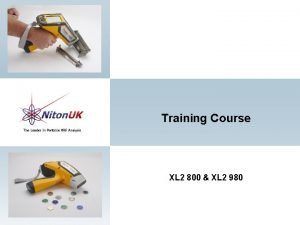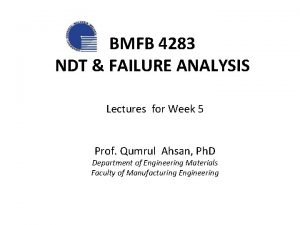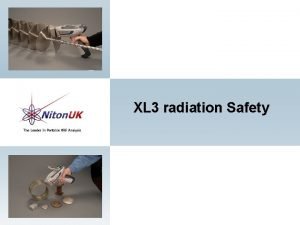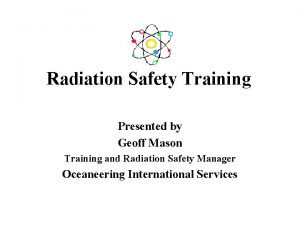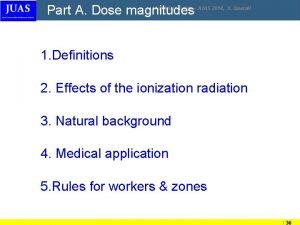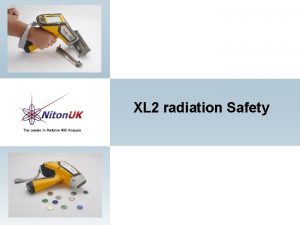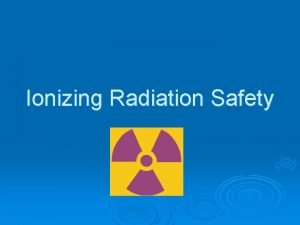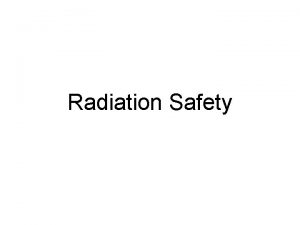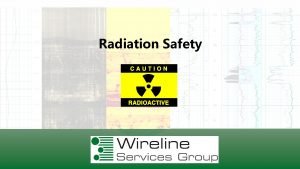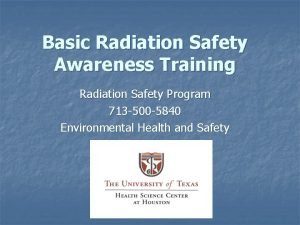XL 2 radiation Safety Radiation Safety The Niton











- Slides: 11

XL 2 radiation Safety

Radiation Safety The Niton Model XL 2 analyser contains an x-ray tube which emits radiation only when the user turns the xray tube on. When the x-ray tube is on and the shutter is open, as during a measurement, the analyser emits a directed radiation beam. Reasonable effort should be made to maintain exposures to radiation as far below dose limits as is practical. This is known as the ALARA (As Low as Reasonably Achievable) principle. For any given source of radiation, three factors will help minimize your radiation exposure: Time, Distance, and Shielding. 2

Time The longer you are exposed to a source of radiation the longer the radiation is able to interact in your body and the greater the dose you receive. Dose increases in direct proportion to length of exposure. 3

Distance The closer you are to a source of radiation, the more radiation strikes you. Based on geometry alone, dose increases and decreases with an inversesquared relation to your distance from the source of radiation (additional dose rate reduction comes from air attenuation). For example, the radiation dose one foot from a source is nine times greater than the dose three feet from the source. Remember to keep your hands and all body parts away from the front end of the analyser when the shutter is open to minimize your exposure. 4

Shielding is any material that is placed between you and the radiation source. The more material between you and the source, or the denser the material, the less you will be exposed to that radiation. Supplied or optional test stands are an additional source of shielding for analysis. A backscatter shield accessory is also available and may be appropriate in some applications. 5

Exposures to radiation Human dose to radiation is typically measured in rem, or in onethousandths of a rem, called millirem (mrem), 1 rem = 1000 mrem. Another unit of dose is the Sievert (Sv), 1 Sv = 100 rem. The allowable limit for occupational exposure in the U. S (and many other countries) is 5, 000 mrem/year (50 m. Sv/year) for deep (penetrating) dose and 50, 000 mrem/year (500 m. Sv/year) for shallow (i. e. , skin) dose or dose to extremities. Deep, shallow, and extremity exposure from a properly used Niton XL 2 analyser should be less than 200 mrem per year, (2. 0 m. Sv per year) even if the analyser is used as much as 2, 000 hours per year, with the shutter open continuously. The only anticipated exceptions to the 200 mrem maximum annual dose are: 1) routine and frequent analysis of plastic samples without use of a test stand, backscatter shield, or similar additional protective measures, or 2) improper use where a part of the body is in the primary beam path. 6

Exposures to radiation cont Also, consider the use of protective accessories such as a shielded test stand or backscatter shield (or equivalent) when performing routine and/or frequent analysis of any of the following: • light materials (such as plastic, wood, or similarly low density/low atomic mass samples) • thin samples (such as foils, circuit boards, and wires) • samples that are smaller than the analysis window. 7

Radiation safety cont When the lights are flashing, the primary beam is on, and radiation is being emitted from the front of the analyser. The primary beam Secondary (Scattered) Beam 8

Radiation safety cont Potential Exposure limit Times Location of Dose Limit Time to Reach Limit Deep Dose / Whole Body 5 rem (50 m. Sv) 2. 1 minutes Shallow Dose / Extremities 50 rem (500 m. Sv) 0. 95 minutes Member of Public (i. e. untrained operator) 0. 1 to 5 rem (1 to 50 m. Sv) 2. 5 to 9. 5 seconds 9

Radiation safety cont Niton XL 2 GOLDD Radiation Profile - Scatter Measurements - m. Sv/hr k. V u. A Range Substrate Max @ 5 cm Max @ 30 cm Max @ Trigger 8 100 Light Plastic <0. 1 8 100 Light Stainless <0. 1 8 100 Light Soil <0. 1 45 44. 4 Main Aluminum 5. 0 <0. 1 45 44. 4 Main Stainless 0. 1 <0. 1 45 44. 4 Main Plastic 50 4. 0 8. 0 45 44. 4 Main Soil 9. 0 <0. 1 10

Radiation safety cont Niton XL 2 GOLDD Radiation Profile - In Beam Measurements - m. Sv/hr k. V u. A Range Contact Deep Contact Shallow 5 cm Deep 30 cm Deep 8 100 Light 0. 1 9800 0. 02 <0. 01 45 44. 4 Main 390 1300 81 5. 1 11
